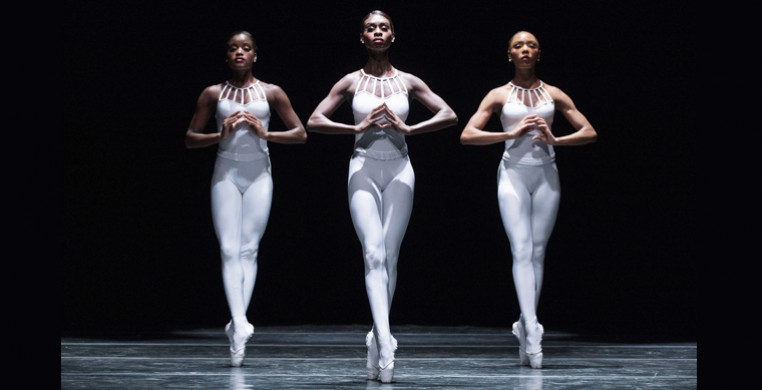After a ten-year hiatus, Dance Theatre of Harlem returned to a cheering Chicago audience Friday at the Auditorium Theatre. A well-balanced program demonstrated the company’s vitality and versatility in the classical lines of resident choreographer Robert Garland’s ethereal “Gloria,” Ulysses Dove’s modernist “Dancing On The Front Porch of Heaven,” and Garland’s funky “Return.” In each of the three pieces, the use of music was a defining factor in the degree to which the choreography achieved structural unity.
Garland’s “Gloria” (2012) opened the program with a breezy perusal of Francis Poulenc’s magnificent liturgical score of the same name. Of particular note is the beguiling use, in the opening and closing of the piece, of beautifully trained children from former DTH principal dancer Homer Bryant's Chicago Multicultural Dance Center. The DTH dancers, as if messengers from heaven in stained glass hues of blues and greens, created a cathedral-like aura in sweeping classical lines, criss-crossing leaps, extensions en pointe, and exalted lifts in rushing group patterns across the stage. Bourées and entre-chat-six mixed with turned-in pas de bourées and jazzy hip swivels in an ever-changing syntax of classicism and modern idioms, with passing nods to Balanchine, Paul Taylor, and Broadway. Intriguing interludes of modern forms intruded briefly on conventional classical ballet combinations. Occasionally, a surprise lift or unusual configuration of three dancers would coordinate so perfectly with the exquisite swell of a soprano voice or orchestral melody that it took your breath away in a stunning visual/auditory moment, but this was not sustained or developed. Program notes tell us that “Gloria” pays homage to Harlem’s spiritual legacy, but the worshipful reverence that pervades much of the piece feels generic. Too often, the choreography devolves into ho-hum classical ballet combinations that rely too heavily on the ecstasy of Poulenc’s soaring orchestrations to carry dramatic momentum in a sound recording that was inexcusably below standard.
A cone of stark white light encircles six dancers dressed in white in Ulysses Dove’s “Dancing On The Front Porch of Heaven” (1993), subtitled, Ode to Love and Loss. Dove used the haunting chimes and searing string orchestra of Arvo Pärt’s “Cantus in Memory of Benjamin Britten” to frame an abstract drama of connection and separation. Angular movement characterized by intense bourées, sharply-accented head and arm gestures, and echapées that stab the ground create a sense of final reckoning. The use of silence in the recurring configuration of the group circle was especially poignant in its understated testimony to loss. A powerful men’s duet of alternating weakness and strength, and a women’s trio of acceleration and stillness revealed the emotional intensity of relationship through sheer movement invention. Six individual solos, each uniquely beautiful and poetic, brought the piece to its culmination. As visually engaging and original as Dove’s movement design is, the complete integration of the music into that design makes the piece truly compelling. Here was a choreographic voice we lost far too soon.
It took a song or two into Robert Garland’s “Return” for the dancers to ground themselves in the music, but once they did, watch out! Ballet with attitude, sass and funk took the stage and what fun it was. Can you make a brisée funky? You better believe it. Here, Garland gets down and nails James Brown and Aretha Franklin’s gut-wail with masterful manipulation of the classical idiom that embraces the essence of the music. In a perfect closer for the program, the Dance Theatre of Harlem crew were so hot, their ballet shoes burned grooves in the stage floor. What can Chicago say to that? Don’t wait so long to come back!

